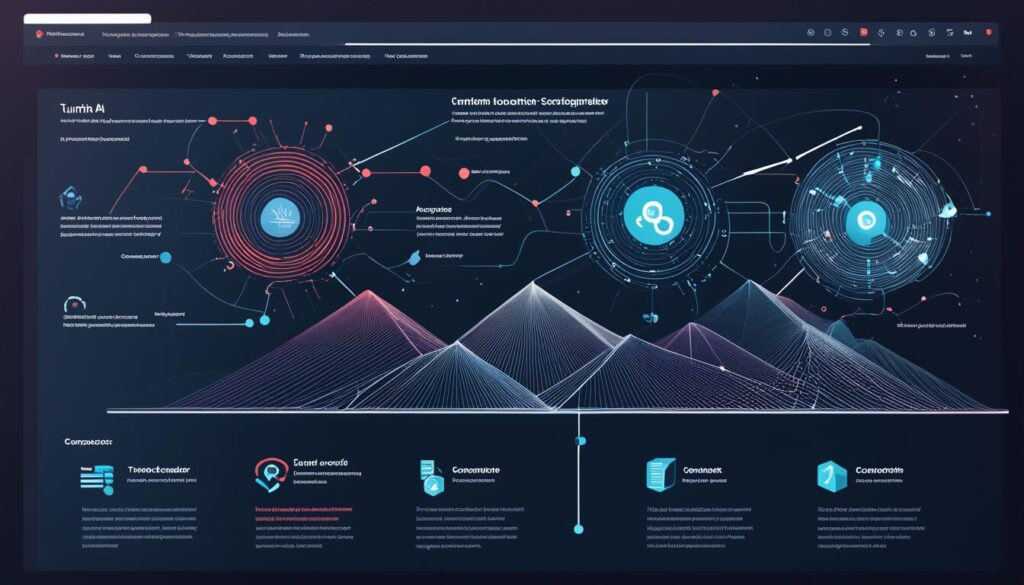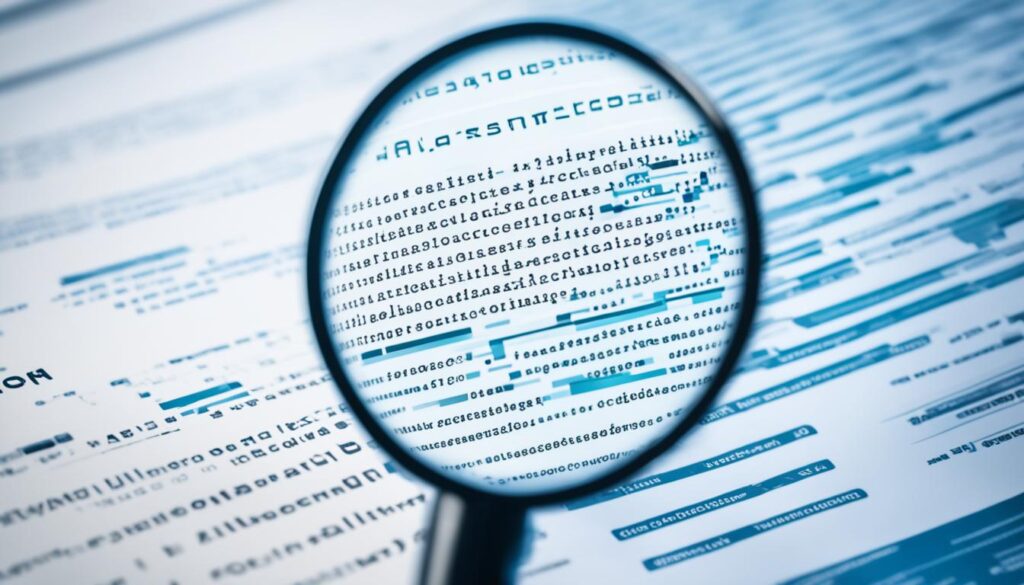“As an Amazon Associate I earn from qualifying purchases.” .
Have you felt unsure after working hard on a project? There are rumors that students use AI like ChatGPT to create human-like text. This AI technology from OpenAI raises big questions about academic honesty. Turnitin, known for spotting plagiarism, says it’s 98% good at finding AI text.
AI text generation is changing the game, making it tough to stay original. Turnitin is fighting back with AI spotting tech that’s really good. But, it can miss some trickier text and newer AIs like Gemini and Claude. Teachers also play a big role, spotting things AI misses with their own skills.
ChatGPT keeps getting better, but so does Turnitin. It uses advanced learning and a huge academic database to check work. Teachers and tech stand together, fighting for real learning and honest work, day by day.
Key Takeaways
- Turnitin aims to maintain academic integrity by detecting AI-generated content with 98% accuracy.
- Turnitin compares submissions against a vast database and uses deep-learning algorithms.
- Teachers supplement technology by detecting inconsistencies in writing styles.
- The system can identify paraphrased AI content and various versions generated by ChatGPT.
- Turnitin’s AI detection tool has limitations and potential blind spots.
- The technology is continuously evolving to keep pace with new AI models like Gemini and Claude.
Overview of Turnitin’s AI Detection Capabilities
It’s key to know how AI content affects academic honesty. Turnitin leads this change, moving from old school to AI technology. Let’s explore Turnitin’s deep AI analysis features’ history and function.
History and Evolution of Turnitin
Turnitin started as the first in its field, using vast academic sources to spot copied work. It has since grown, adding statistical checks to find potential cheats. This growth keeps Turnitin sharp and helpful.
Introduction of AI Writing Detection
To tackle new challenges from AI text, Turnitin added AI writing detection. This was in response to AI like ChatGPT creating very natural text. Turnitin’s AI detection features proved the most precise of 16 in IDing AI or human content in 126 documents reviewed.
How Turnitin’s AI Detection Works
Turnitin’s AI system is complex. It recognizes AI text styles using old data and adds new AI text models seamlessly. This capability is part of the Originality tool, helping teachers spot AI writing with great accuracy.
| Detector | Accuracy (out of 126 documents) |
|---|---|
| Turnitin | 126/126 |
| Originality | 125/126 |
| Copyleaks | 124/126 |
Turnitin avoids common mistakes well, giving fair results to educators. Studies show little bias, with similar low error rates for English language learners and native speakers. This fairness shows Turnitin’s strong values in accurate assessment, so chatgpt academic integrity is upheld.
How Turnitin Identifies AI-Generated Content
Turnitin uses several ways to spot AI-made content. It checks in a big database, looks for writing patterns, and does statistical checks. These methods are key to keeping gpt content authenticity in schoolwork safe.

Database Comparison and Matching
It compares work against a huge collection of already published material. This includes academic papers, journals, and articles. Discussions like these exist around database comparison and matching.
Turnitin is used by 34 million students all over from 153 countries. It keeps getting better to find content made by ChatGPT, with a 99% success rate according to its website.
Writing Pattern Recognition
Writing pattern recognition is a big part of Turnitin. It finds specific writing styles AI often uses. But, it can find some AI works harder, like content in lists or tables. This shows we need better ways to catch all AI-made texts.
Statistical Analysis of Text
Turnitin checks the structure and words in a document. In one report, it could find 6 out of 16 AI texts. It’s good at not flagging real content by mistake, but it might not catch 15% of AI content. This can be a flaw.
For Turnitin to work well, it needs at least 300 words per check. The more information it has, the more sure its check is. And, by checking many real texts, Turnitin’s AI keeps getting better at finding fake content.
Does Turnitin Detect Chat GPT Content?
Turnitin is now able to spot content produced by ChatGPT. It started doing this on April 4, 2023. Over 2.1 million teachers, 10,700 schools, and about 62 million students use it. Turnitin has advanced a lot and keeps getting better to catch AI writing.
Case Studies and Real-World Examples
There are many studies showing Turnitin can find AI-made content. It does this by noting certain writing patterns, like repeating sentences and lacking original ideas. These studies help educators trust Turnitin’s ability to identify AI writing.
Accuracy and Reliability of Detection
Turnitin says it is right 98% of the time when detecting Chat GPT content. A study by The Washington Post found Turnitin correctly marked 6 out of 16 AI articles. It missed 3. But, its false alarm rate is only 1%. Turnitin stays ahead by updating to catch new versions of AI text generators.
Impact of AI Detection on Academic Integrity
Challenges in academic integrity are rising due to tools like ChatGPT. It is tough for schools to keep work honest. Turnitin’s AI advances play a key role in this.

Challenges Faced by Educational Institutions
Educational places find it hard to use AI detection well. A Turnitin study from 2023 found three times more students than teachers use AI tools. It said 46% of students will keep using these tools, even when banned. This shows the need for strong AI detection and updated rules.
Ensuring Fair Assessment of Student Work
AI tools can help assess student work fairly by spotting AI content. Turnitin found very few false alarms (less than 1% in over 20% AI content uploads). This is key for accurate grading.
But, educators must also look at the work to ensure fairness. Even though Turnitin says it’s 98% accurate in spotting AI work, human judgment is still crucial for detailed reviews.
“AI detection tools offer a supportive role in upholding academic integrity by accurately identifying AI-generated content. Their integration must be balanced with informed assessments by educators to ensure fairness and learning quality,” — Turnitin Vice President of AI.
Many want to use AI tools for better academic honesty. An 81% majority feel teachers should use these tools. This strong support shows the need for AI in keeping academic areas honest.
Limitations and False Positives
Even with cutting-edge AI detection, Turnitin isn’t perfect. It sometimes marks real student work as AI-made. Knowing these limits helps us use tech and human judgment together.
Understanding False Positives
Turnitin’s AI is usually very accurate but it can make mistakes. False positives are rare, but they can hurt students. This happens when AI and human writing look too similar.
The Washington Post saw this when testing Turnitin. It correctly spotted 6 out of 16 AI texts. But, it missed 3 and wrongly marked under 1% as problematic. This shows we must know about false positives to deal with them.
One downside is Turnitin needing 300 words to spot AI writing. This can make it less correct with shorter pieces. Also, it’s not good at finding AI help in non-essay formats like lists. So, teachers should understand why false positives happen.
Instructor’s Role in Evaluation
Teachers play a big part in handling Turnitin’s results. They look closely at what the tool marks and share its reports with students. This helps sort out any mistakes.
Schools now let teachers turn off Turnitin to rely more on their judgment. By discussing Turnitin’s reports with students, they make grading fair and clear. This method promotes honesty in learning.
Turnitin is a big step against cheating, but it still needs human oversight. Knowing its limits is key to fair grading. This way, academic reviews are just and accurate.
Conclusion
On April 4, 2023, Turnitin introduced AI to spot AI-written content. This move boosts academic honesty. It is very accurate, spotting ChatGPT texts 98% of the time. This helps 62 million students across 10,700 schools.
Turnitin can pinpoint AI-written content well, giving a detailed report. Yet, it only checks against known content to see if it’s very similar (0-24% match). This might not catch all plagiarism, especially with new AI models.
As AI writing tools keep improving, Turnitin needs to stay ahead. It plans to better find copied content and deal with reworded texts. By working with teachers, Turnitin hopes to really make a difference in catching plagiarism.
FAQ
Does Turnitin detect ChatGPT-generated content?
What methods does Turnitin use to detect AI-generated text?
How accurate is Turnitin’s AI detection?
Can Turnitin’s system yield false positives?
What are the key challenges faced by educational institutions with AI writing tools like ChatGPT?
How does Turnitin’s database comparison work for AI detection?
What role do instructors play in evaluating AI-generated content flagged by Turnitin?
How has Turnitin evolved to address the surge in AI-generated content?
How does Turnitin recognize writing patterns indicative of AI-generated content?
How does Turnitin’s statistical analysis contribute to AI detection?
What has been the impact of AI detection on academic integrity?
Source Links
- https://inboundblogging.com/can-turnitin-detect-chat-gpt/
- https://www.turnitin.com/solutions/topics/ai-writing/
- https://editgpt.app/can-turnitin-detect-chat-gpt
- https://whatsthebigdata.com/can-turnitin-detect-chat-gpt/
- https://trickmenot.ai/does-turnitin-detect-chat-gpt/
- https://www.turnitin.com/blog/ai-writing-detection-what-academic-leaders-need-to-know-as-technology-matures
- https://rdene915.com/2023/04/07/new-ai-detection-feature-via-turnitin/
- https://www.insidehighered.com/news/2023/04/03/turnitins-solution-ai-cheating-raises-faculty-concerns
- https://www.jdsupra.com/legalnews/chatgpt-and-ai-detection-tools-the-1617850/
- https://medium.com/@conor_75014/can-turnitin-detect-chatgpt-lets-find-out-8ca6e2471b1e
- https://www.androidauthority.com/can-turnitin-detect-chatgpt-3333841/
“As an Amazon Associate I earn from qualifying purchases.” .



